Slow down on your way to Kgalagadi where you will find not only burnished sand and camelthorn trees, but a surprise of intriguing, delicious and charming Kalahari stops

‘When it rains in the Kalahari,” it’s Pancake Day. Or so Johanna du Toit told me over coffee on the back stoep of Diamond T Coffee Shop in Askham, deep in Kalahari territory where the land hikes up its skirt between Botswana and Namibia. It’s frontier land, once a lawless pocket of the country where legendary characters like Scotty Smith roamed. The days of the old rascal, raconteur and Robin Hood of southern Africa are long over, and the dusty road that once ran up to the border has now been transformed into a good stretch of tar. The traffic along the R360 has increased accordingly with travellers gliding along from the sprawling town of Upington to the Kgalagadi Transfrontier Park. In between lie small settlements, salt pans and diamonds just waiting to be discovered. And, it had just rained.
The Kalahari was green and blooming, with long green grass, purple thunderbolts and bright yellow ‘dubbeltjie’ flowers trailing innocently over the ground belying their devilish thorns, which would later painfully hitch rides with many an unfortunate passer-by. I was happily lapping up this unusual view of the Kalahari as I chatted to Johanna. Two children played in the garden next to a rusty old car door on which was scrawled a quote from ex-warden Elias Le Riche, last in the line of Kgalagadi’s legendary Le Riche wardens. They had kept the position in the family for more than fifty years, passing it from brother to brother and father to son. It read: ‘Die Kalaharie is ‘n man se hemel, ‘n vrou se verdriet en ‘n motorcar se hel’ (The Kalahari is a man’s heaven, a woman’s misery and a motor car’s hell).
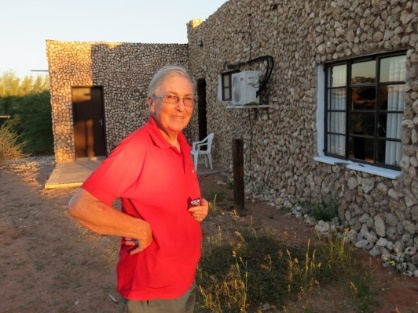


Johanna filled me on the history of Askham and the name of the coffee shop taken from the buses that once travelled the route between Upington and Noenieput, 120km away. The first bus used was an old Albion, later replaced with a shiny red Diamond T. The driver, ‘Oom Van’ van Rensburg, delivered the school children COD – cash on delivery! – to a Mr Van den Berg, the headmaster of the small school and owner of the only shop in Askham, who matter-of-factly added the payment to the parents’ grocery bills. On cold winter mornings, the boys had to push the bus to get it going. The gravel road was maintained by Oom Willie Jacobs, with his grader and team of 16 donkeys.
The story was interrupted by the arrival of my glass of homemade ginger beer, served with a heart-shaped biscuit and a quotation from the bible. Like everything produced in the coffee and gift shop, it radiated love. Johanna and Cilla du Toit joined forces in 2011, combining their culinary and artistic skills and talents. Housed in the old Railway building once serving as an overnight spot for the bus drivers, the shop, like the buses of old, brings life to the small Kalahari town. While we were talking, the pastor’s Jack Russell ran over with tail wagging to say hello. “That means he’s in Noenieput,” Johanna told me. As the pastor commutes between the two towns, church services are held on alternate Sundays. I had heard of Diamond T’s fame long before my visit, their friendliness and small town charm, as well as their popular springbok pies and ‘Kruger’s wors (sausage)’ made by Johanna’s husband. News flies by word of mouth in the Kalahari, as it must always have done.


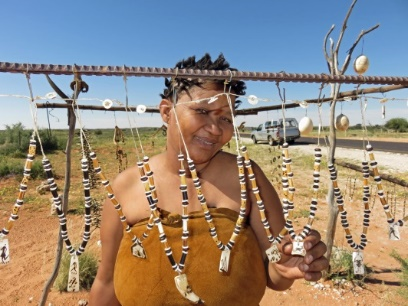
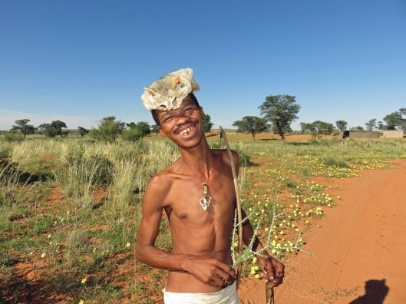
I soon got wind of Gertruida Bott and her excellent reputation for providing a feast of boerekos - farmers’ fare. She had made a name for herself catering for groups at Hakskeen Pan, the 20km long mud and salt pan near Rietfontein. Her customers arrive for the adrenalin-rousing speed-week usually held in September (a major event in the region), where competitors attempt to break the land-speed record, and for the many bike rallies.
Gertruida makes and serves her traditional food (booking essential) from her Kalahari Tented Camp and coffee shop near the pan and the Rietfontein border post. Dishes include curry tripe, skaap-koppe (sheep heads) – or if a tamer meal is requested – rice and vleis (meat) with roosterkoek, stampmielies and pumpkin cakes. Kalahari boerewors rolls – long roosterkoek filled with spicy sausage – are another favourite. “I really go out of my way for my customers,” Gertruida told me, exuding her authenticity and warmth. Then, she shared her secret, “Die pad na ‘n man se hart gaan deur sy maag (The way to a man’s heart is through his stomach),” and laughed.

Before continuing along the route - dubbed the Red Dune Route - towards the transfrontier park, which blurs the boundaries between South Africa and Botswana in an inspiring conservation effort, I made a stop for a San (Bushman) walk. Although the true people of the desert have long gone from this area, the current generation now integrated into modern society, their spirit will always linger in the soulful desert wilderness. Some folk, like the small team at Boesmansrus, are trying to revive some of the culture while providing a livelihood for themselves. Barbara Raats started the ‘living museum’ in 2010 with her husband and a friend. Barbara told me that she opened the museum to keep the traditions alive. “When I have a group of people, I take some of the children with me to learn, so they can have the knowledge when there are no longer people to teach them.” The Khomani-San bushwalk revealed tracks on the sand and desert-adapted plants. Oushé, one of my guides, pointed to a jumble of tracks in the red sand relaying the story of all who had crossed in the last day. “There’s a mouse,” he said with a gleam in his eye, “a bakkie, a Bushman and a millipede.”

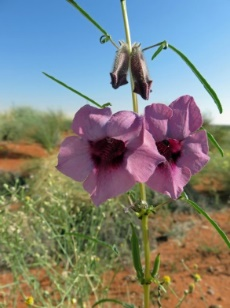

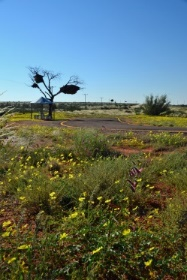
Thirty-five kilometres south of Twee Rivieren at Kalahari Trails aka the Meerkat Sanctuary, I had the opportunity to discover the next diamond and spent days in the rustic campsite dazzled by its splendour. Professor Anne Rasa, a pioneer in the study of social mongooses, has spent most of her life studying animal behaviour and desert ecology. A font of knowledge and wisdom gleaned from years of both academic and field work, Anne started Kalahari Trails with the idea of giving people a different view of the Kalahari on her guided bush walks. “Here we look at small things, spiders, beetles etc. “I call it reading last night’s newspaper,” Anne explained. I was having difficulty concentrating as meerkats started to stream through the door and mill around Anne’s feet, tumbling playfully. This steered us onto our next conversation about the Meerkat Sanctuary. Unwittingly, Anne became a meerkat guardian as Nature Conservation and the police started to bring her rescued meerkats that had been confiscated from people who had flushed them from their burrows and were trying to keep them or sell them as pets. Anne had cared for these traumatised and often sick animals informally for years, until last year when Nature Conservation suggested she start a formal sanctuary. She took their advice and opened the Meerkat Sanctuary, digging deep into her own pocket and relying on donations from the public to keep it running smoothly. Visitors are welcome to pop in during the late afternoons to see the meerkats when they gather for their evening feed. Overnight guests can join the guided morning walk, where if lucky, they will have the meerkats trailing after them.

Anne’s strategy is to keep the meerkats as wild as possible - and she doesn’t encourage petting, so that when they are healed and healthy they return naturally to the wild. At the time of my visit she had her largest group to date of 12 animals, which had formed a happy family group. I watched them for a while, noticing how they had assumed various roles as babysitters or guards. They had comfortably included Anne in their family. She could speak their language. The image of meerkats catching the last of the afternoon’s sun rays stayed with me as did my time in this unexpectedly charming stretch of the country. I recalled Anne’s words about her beloved home as the sun tinged tufts of meerkat fur in gold: “It’s very good for the soul. I call it Kalahari soul food.”
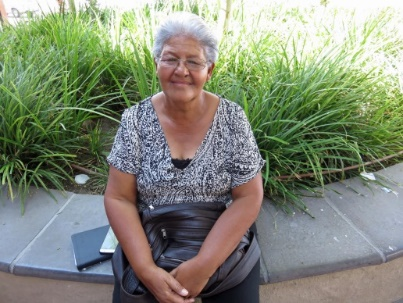
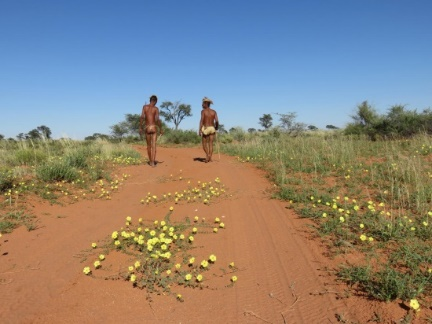
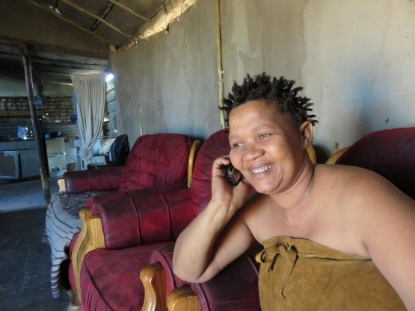
www.ncfamouslodges.co.za/Molopo
Contact details:
Diamond T Coffee Shop, Askham: 078 279 4774 (Johanna), 082 496 9941 (Cilla), 054 511 0025 askhamk@mweb.co.za, www.aridexperiences.com/dtcs
Kalahari Info & Tented Camp (& Coffee Shop), Rietfontein: 072 159 6726/063 0480 706 info@miertourism.co.za, www.miertourism.co.za
Boesmansrus (A few kilometres west of Askham on the R31): 078 328 0578, bonaraats@gmail.com
Kalahari Trails and Meerkat Sanctuary (35km south of Kgalagadi on the R360): 072 277 2377/054 511 0900, kalahari.trails@intekom.co.za, www. kalahari-trails.co.za, www.Facebook.com/kalaharitrails
Things to do:
Visit the Meerkat Sanctuary in the late afternoon (by donation)
Join a guided morning walk (with the meerkats), a game- or sundowner-drive at Kalahari Trails Nature Reserve
Visit the Khomani-San for a bush walk
Make a reservation for a spa treatment with the Diamond T ladies, if staying over in Askham
Enjoy a light meal or springbok pie at Diamond T Coffee and Gift Shop in Askham
Savour a home-cooked traditional meal at Kalahari Tented Camp & Coffee Shop on the outskirts of Rietfontein
Explore the Kgalagadi Transfrontier Park
Where to stay:
Several guestfarms, guesthouses, lodges and camps provide guests with ample choice of accommodation along this route, with options to float in a salt pan or ride a camel through the dunes. Visit www.aridexperiences.com/reddune for more information.